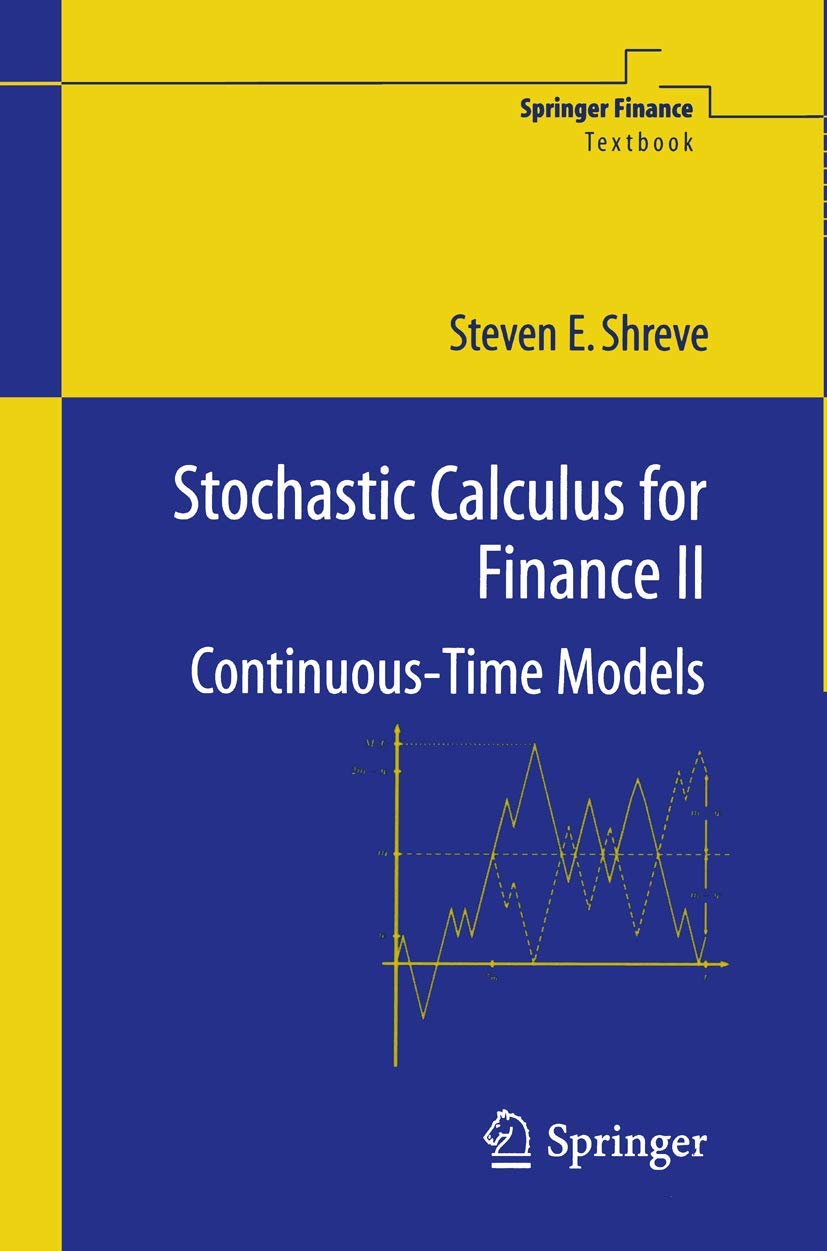Solution Manual to Stochastic Calculus for Finance II
Stochastic Calculus for Finance II is one of the most accessible books in mathematical finance. The prerequisites for understanding the material include familiarity with graduate-level probability theory and a solid knowledge of mathematical analysis. Here, I have compiled the solutions I prepared for the exercises in this book.

Click here to access the repository containing all the solutions. For your convenience, I have also included them below.
Chapter 1 (General Probability Theory)
Exercise 1.1
Exercise 1.2
Exercise 1.3
Exercise 1.4
Exercise 1.5
Exercise 1.6
Exercise 1.7
Exercise 1.8 (Moment generating function)
Exercise 1.9
Exercise 1.10
Exercise 1.11
Exercise 1.12
Exercise 1.13 (Change of measure for a normal random variable)
Exercise 1.14 (Change of measure for an exponential random variable)
Exercise 1.15
Chapter 2 (Information and Conditioning)
Exercise 2.1
Exercise 2.2
Exercise 2.3 (Rotating the axes)
Exercise 2.4
Exercise 2.5
Exercise 2.6
Exercise 2.7
Exercise 2.8
Exercise 2.9
Exercise 2.10
Exercise 2.11
Chapter 3 (Brownian Motion)
Exercise 3.1
Exercise 3.2
Exercise 3.3 (Normal kurtosis)
Exercise 3.4 (Other variations of Brownian motion)
Exercise 3.5 (Black-Scholes-Merton formula)
Exercise 3.6
Exercise 3.7
Exercise 3.8
Exercise 3.9 (Laplace transform of first passage density)
Chapter 4 (Stochastic Calculus)
Exercise 4.1
Exercise 4.2
Exercise 4.3
Exercise 4.4 (Stratonovich integral)
Exercise 4.5 (Solving the generalized geometric Brownian motion equation)
Exercise 4.6
Exercise 4.7
Exercise 4.8 (Solving the Vasicek equation)
Exercise 4.9
Exercise 4.10 (Self-financing trading)
Exercise 4.11
Exercise 4.12
Exercise 4.13 (Decomposition of correlated Brownian motions into independent Brownian motions)
Exercise 4.14
Exercise 4.15 (Creating correlated Brownian motions from independent ones)
Exercise 4.16 (Creating independent Brownian motions to represent correlated ones)
Exercise 4.17 (Instantaneous correlation)
Exercise 4.18 (State price density process)
Exercise 4.19
Exercise 4.20 (Local time)
Exercise 4.21 (Stop-loss start-gain paradox)
Chapter 5 (Risk-Neutral Pricing)
Exercise 5.1
Exercise 5.2 (State price density process)
Exercise 5.3
Exercise 5.4 (BSM formula for time-varying, non-random interest rate and volatility)
Exercise 5.5
Exercise 5.6
Exercise 5.7
Exercise 5.8 (Every strictly positive asset is a generalized geometric Brownian motion)
Exercise 5.9 (Implying the risk-neutral distribution)
Exercise 5.10 (Chooser option)
Exercise 5.11 (Hedging a cash flow)
Exercise 5.12 (Correlation under change of measure)
Exercise 5.13
Exercise 5.14 (Cost of carry)
Chapter 6 (Connections with Partial Differential Equations)
Exercise 6.1
Exercise 6.2 (No-arbitrage derivation of bond-pricing equation)
Exercise 6.3 (Solution of Hull-White model)
Exercise 6.4 (Solution of Cox-Ingersoll-Ross model)
Exercise 6.5 (Two-dimensional Feynman-Kac)
Exercise 6.6 (Moment-generating function for Cox-Ingersoll-Ross process)
Exercise 6.7 (Heston stochastic volatility model)
Exercise 6.8 (Kolmogorov backward equation)
Exercise 6.9 (Kolmogorov forward equation)
Exercise 6.10 (Implying the volatility surface)
Chapter 7 (Exotic Options)
Exercise 7.2 (Boundary conditions for the up-and-out call)
Exercise 7.3 (Markov property for geometric Brownian motion and its maximum to date)
Exercise 7.4 (Cross variation of geometric Brownian motion and its maximum to date)
Exercise 7.6 (Boundary conditions for lookback option)
Exercise 7.7 (Zero-strike Asian call)
Exercise 7.8
Exercise 7.9
Chapter 8 (American Derivative Securities)
Exercise 8.1 (Determination of L_* by smooth pasting)
Exercise 8.2
Exercise 8.3 (Solving the linear complementarity conditions)
Exercise 8.4
Exercise 8.5 (Perpetual American put paying dividends)
Exercise 8.6 (Optional sampling)
Exercise 8.7
Chapter 9 (Change of Numeraire)
Exercise 9.1
Exercise 9.2 (Portfolios under change of numeraire)
Exercise 9.3 (Change in volatility caused by change of numeraire)
Exercise 9.4
Exercise 9.5 (Quanto option)
Exercise 9.6
Chapter 10 (Term-Structure Models)
Exercise 10.1 (Statistics in the two-factor Vasicek model)
Exercise 10.2 (Ordinary differential equations for the mixed affine yield model)
Exercise 10.3 (Calibration of the two-factor Vasicek model)
Exercise 10.4
Exercise 10.5 (Correlation between long rate and short rate in the one-factor Vasicek model)
Exercise 10.6 (Degenerate two-factor Vasicek model)
Exercise 10.7 (Forward measure in the two-factor Vasicek model)
Exercise 10.9 (Multifactor HJM model)
Exercise 10.10
Exercise 10.11
Exercise 10.11
Notes
Exotic Options
Feynman-Kac Theorem
Dupire’s Formula
Implied Volatility
Basic Concepts (Short Notes)
Cheat Sheet
